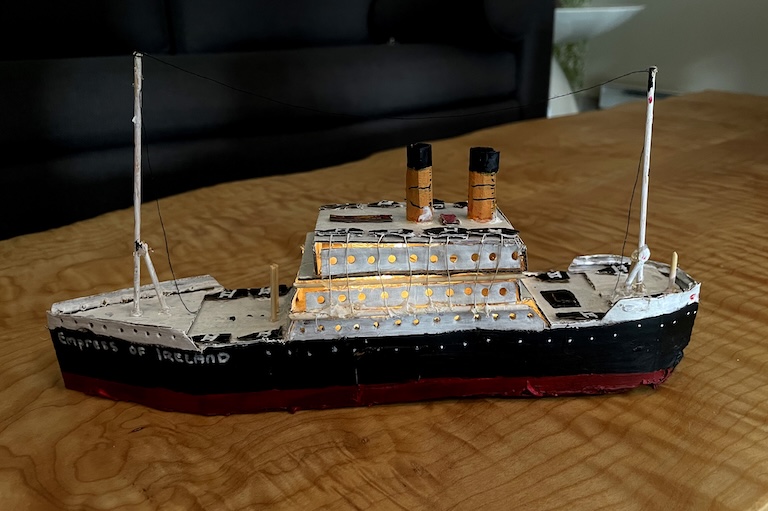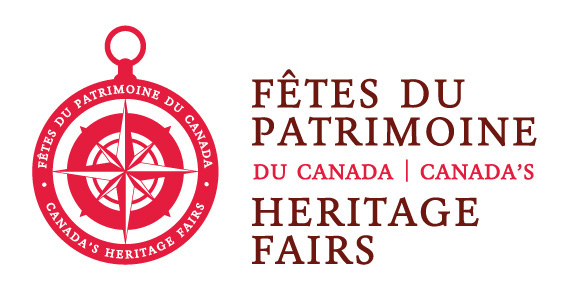Sofia R-M.

Canada’s Titanic, The Empress of Ireland
Sofia R-M
From River to Sea Heritage Fair
Burnaby, BC
My project explores The Empress of Ireland, which collided with the Norwegian collier Storstad on the Saint Lawrence River. On May 29th, 1914, the Empress of Ireland was on its way to Liverpool, carrying over 1,000 passengers and crew. The Storstad had departed North Sydney, Nova Scotia, carrying tons of cargo. When the two ships were a short distance apart, fog rolled in, and they were unable to see each other's lights. Instead, they had to use audible boat signals to indicate their presence. However, in my opinion, the signals were misleading, and by the time the fog had lifted, it was already too late. The ships were far too close, and they collided, leaving a gaping hole at least 14 feet wide in the Empress of Ireland. The ship sank in less than 15 minutes, making it one of the fastest sinkings in maritime history. 338 people survived, and among the 134 children, only 4 lived. However, the Storstad was smashed and twisted in its front, but could still finish its voyage to Montreal. After the Titanic disaster in 1912, the Empress of Ireland had already switched from wooden to steel lifeboats because the
Titanic’s wooden lifeboats broke during the collision due to the freezing cold water. This shows that lessons from the Titanic had already started to influence safety design. Today, we have better boat signal systems and more watertight doors than before. When the Empress of Ireland was built in 1906, its twin ship, the Empress of Britain, was also constructed, and they were some of the largest ships at the time. When the Empress of Ireland sank, engineers learned that it did not have enough watertight doors, so more were added to the Empress of Britain, improving its safety. Unfortunately, the Empress of Britain was later sunk by a German submarine in 1940 during World War II.
What sources and evidence did you consult for your project? What different perspectives did they provide on your topic?
These are the main sources I used to collect my data:
- Video: Casual Navigation. “Why Did She Sink so Fast? | RMS Empress of Ireland.” YouTube, 29 Apr. 2022.
This video explained why the boat sank so quickly and was what inspired my inquiry question.
- Book: Marshall, Logan. The Tragic Story of the Empress of Ireland. Philadelphia?, 1914.
This book gave me a different death toll than other online sources, so I based my data on the number I saw the most. However, I still question whether any of them are truly accurate! Besides that, the book was very interesting and shared stories of people who were on board, including some survivors and how they made it out alive.
- Website: “Navigation Sounds : BoatUS Foundation.” BoatUS Foundation, 2024.
This website taught me what the boat signals meant. I used this information in one of my subtopics, which led me to the opinion that the Empress of Ireland signals were misleading. This was because the Empress signalled that it was going full speed, but never indicated the exact direction.
- Website: The Salvation Army. “The Salvation Army in Canada.” The Salvation Army in Canada, 2017.
I used this website to learn about the Salvation Army, so I could understand why they were on the Empress of Ireland and where they were going. Learning about all the good they do to help people made it heartbreaking to know that the majority of them-, including the chief commander- died in the disaster.
 A model of the Empress of Ireland created by Sofia.
A model of the Empress of Ireland created by Sofia.
What is the historical significance of your topic?
It is important to examine the reasons behind the collision to help prevent similar disasters in the future. Families- especially those who lost children- would have had to deal with heartbreaking news. Survivors may have experienced trauma of seeing what happened right in front of them, such as people drowning and having to choose between saving themselves or someone else. Some may have struggled with the fear of ever going on a ship again. In the shortly after the disaster, the Empress of Britain installed more watertight doors to improve safety. In the long term, improvements were made to baot signals, watertight compartments, and route management. These changes have made travel by sea much safer today.
Why did you choose this topic?
I chose this project initially because I knew that I’ve always loved stories that are detailed and full of action. A ship collision meant that there would be lots of interesting facts to discover. When I read about the death tolls, I wanted to understand how and why so many people died. As I explored the topic, more questions came up. I discovered that the Empress of Ireland was the fastest passenger ship to ever sink and that its wreck is considered one of the most beautiful in the world. I became very passionate about the topic and wanted to keep learning more.

